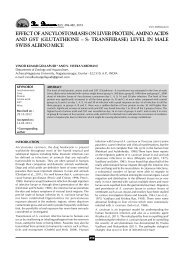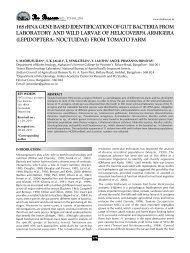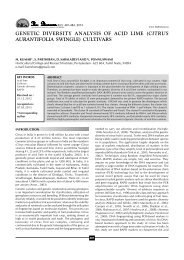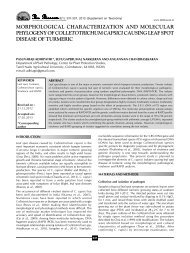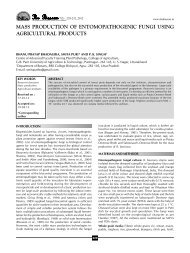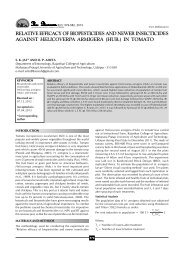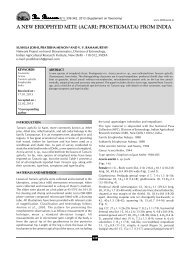Isolation and characterization of PGPR associated ... - THE BIOSCAN
Isolation and characterization of PGPR associated ... - THE BIOSCAN
Isolation and characterization of PGPR associated ... - THE BIOSCAN
You also want an ePaper? Increase the reach of your titles
YUMPU automatically turns print PDFs into web optimized ePapers that Google loves.
A. KUSHWAHA et al.,<br />
strains that are compatible with cauliflower.<br />
MATERIALS AND METHODS<br />
<strong>Isolation</strong> <strong>of</strong> <strong>PGPR</strong> from cauliflower rhizosphere<br />
Sample collection<br />
Soil samples were collected from the rhizosphere <strong>of</strong> two monthold<br />
cauliflower plants. The rhizosphere was dug out with intact<br />
root system. The samples were placed in plastic bags <strong>and</strong><br />
stored at 4ºC.<br />
Bacterial isolation<br />
Ten grams <strong>of</strong> rhizosphere soil were taken into a 250mL <strong>of</strong><br />
conical flask <strong>and</strong> 90mL <strong>of</strong> sterile distilled water was added to<br />
it. The flask was shaken for 10min on a rotary shaker. One<br />
milliliter <strong>of</strong> suspension was added to 10mL vial <strong>and</strong> shaken<br />
for 2min. Serial dilution technique was performed upto 10-7 dilution. An aliquot (0.1mL) <strong>of</strong> this suspension was spread on<br />
the plates <strong>of</strong> Luria Bartany (LB) agar medium. Plates were<br />
incubated for 3 days at 28ºC to observe the colonies <strong>of</strong><br />
bacteria. Bacterial colonies were streaked to other LB agar<br />
plates <strong>and</strong> the plates were incubated at 28ºC for 3 days. Typical<br />
bacterial colonies were observed over the streak. Well isolated<br />
single colony was picked up <strong>and</strong> re-streaked to fresh LB agar<br />
plate <strong>and</strong> incubated similarly.<br />
Identification <strong>of</strong> isolates<br />
The bacterial strain was studied for cultural, morphological<br />
<strong>and</strong> biochemical characteristics based on Bergey’s Manual <strong>of</strong><br />
Systematic Bacteriology (Hoit et al., 1989).<br />
Cultural characteristics<br />
All the isolates were streaked on LB agar plates. After 3 days <strong>of</strong><br />
incubation, different characteristics <strong>of</strong> colonies such as growth,<br />
form <strong>and</strong> colour.<br />
Morphological characteristics<br />
The suspected organisms were subjected to Gram’s staining<br />
(Vincent, 1970). The bacteria which retained the primary stain<br />
called gram + ve while those that lost the crystal violet <strong>and</strong><br />
counter stained by safranin were referred as gram – ve.<br />
Biochemical <strong>characterization</strong><br />
Methyl Red test<br />
Tubes containing the sterilized MR –VP broth were inoculated<br />
with isolated bacterial strains <strong>and</strong> one tube as uninoculated<br />
comparative control. Then all the inoculated <strong>and</strong> uninoculated<br />
tubes were incubated at 37ºC for 48h. After 48h <strong>of</strong> incubation<br />
5 drops <strong>of</strong> methyl red indicator was added to each tube. When<br />
methyl red was added, it remained red which was indicative<br />
<strong>of</strong> positive test while turning <strong>of</strong> methyl red to yellow indicated<br />
the negative test.<br />
Hydrogen sulfide production test<br />
The inoculum was stab inoculated onto the SIM agar medium<br />
<strong>and</strong> incubated at 37ºC for 48h. Blackening <strong>of</strong> the culture<br />
medium indicated a positive test while no change in colour <strong>of</strong><br />
the medium indicated a negative test.<br />
Catalase test<br />
The hydrogen peroxide solution (2%) was added to the culture<br />
on a slide. The release <strong>of</strong> free oxygen bubbles indicated a<br />
96<br />
positive test.<br />
Casein Hydrolysis test<br />
The casein agar plate was streaked with the isolated organism<br />
in sterile condition. After that the plates were incubated at<br />
37ºC for 24-48h in an inverted position (Seeley <strong>and</strong><br />
V<strong>and</strong>emark, 1970). A clear zone surrounding the bacterial<br />
growth indicated the positive reaction for extracellular<br />
caseinase secretion while absence <strong>of</strong> clear zone indicated the<br />
negative reaction.<br />
Gelatin Hydrolysis test<br />
Gelatin agar medium was melted <strong>and</strong> cooled to 45-50ºC to<br />
pour into four sterile petri dishes. All the inoculated <strong>and</strong><br />
uninoculated (control) plates were incubated at 37ºC for 4 -7<br />
days. After incubation, plates were placed in refrigerator at<br />
4ºC for 24h. The incubated agar plates were flooded with<br />
mercuric chloride solution <strong>and</strong> the plates were allowed to<br />
st<strong>and</strong> for 5 to 10 minutes. Then plates were examined for<br />
clearing zone around the line <strong>of</strong> growth (Blazevic <strong>and</strong> Ederer,<br />
1975).<br />
Indole test<br />
The isolated organism was inoculated into tryptone broth the<br />
inoculated <strong>and</strong> uninoculated (control) tubes were incubated<br />
at 37ºC for 48h. After incubation, Kovac’s reagent was added<br />
to inoculated <strong>and</strong> control tubes. Development <strong>of</strong> cherry red<br />
colour at the top layer in the form <strong>of</strong> ring indicated the positive<br />
test while its absence indicated the negative test.<br />
Ammonia production test<br />
Fresh culture were inoculated into 10mL peptone water <strong>and</strong><br />
incubated for 48-72h at 37ºC. Nessler’s reagent (0.5mL) were<br />
added to each tube <strong>and</strong> development <strong>of</strong> yellow to brown<br />
colour was considered as positive test while no change in<br />
colour showed negative test (Cappuccino <strong>and</strong> Sherman ,<br />
1992).<br />
Phosphate solubilization test<br />
The bacterial isolates were inoculated into plates with sterilized<br />
Pikovskaya medium containing tricalcium phosphate <strong>and</strong><br />
incubated at 30ºC for 72h. Formation <strong>of</strong> clear zone around<br />
the colony indicated the phosphate solubilizaton by the<br />
bacteria (Pikovaskya, 1948).<br />
Growth under different temperature condition<br />
Cultures (24h old) <strong>of</strong> the isolated bacterial strains were streaked<br />
on LB Agar plates <strong>and</strong> incubated for 24-48h at 4ºC, 12ºC,<br />
28ºC <strong>and</strong> 37ºC. The change in growth <strong>and</strong> colour were<br />
observed.<br />
Pot experiment<br />
A soil sample was collected from the plots where cauliflower<br />
was produced for the past several years. The soil was sieved<br />
<strong>and</strong> mixed with thoroughly washed <strong>and</strong> dried s<strong>and</strong> in a<br />
proportion <strong>of</strong> 3:1 (soil: s<strong>and</strong>). The soil <strong>and</strong> s<strong>and</strong> mixture was<br />
then autoclaved for 15 mins at 121ºC. A h<strong>and</strong> full seeds <strong>of</strong><br />
cauliflower were surface sterilized with 0.5% (w/v) HgCl at 2<br />
room temperature <strong>and</strong> thoroughly washed with sterilized<br />
distilled water (Sirisk<strong>and</strong>arajah et al., 1993). Then 24h fresh<br />
isolated bacterial cultures were inoculated into 10mL LB broth<br />
<strong>and</strong> incubated for 24h at 37ºC <strong>and</strong> 12 sterilized seeds were<br />
added to each tube. After 24h <strong>of</strong> incubation, 5 seeds were<br />
sown to each <strong>of</strong> the 4 pots <strong>and</strong> control seeds were incubated



